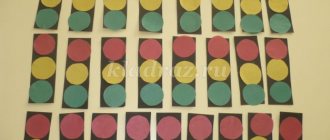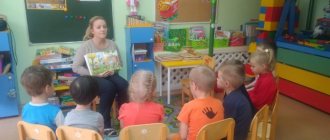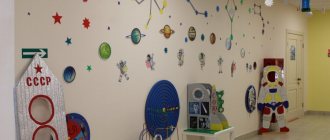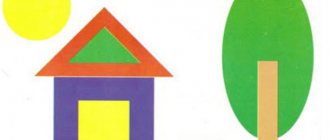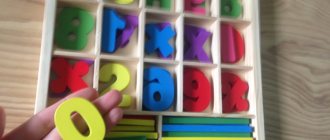“Games for the sensory development of children in the middle group”
Games for sensory development of middle school children
D. I. “Picture from figures”
Goal: develop
the ability to differentiate geometric figures of different shapes and sizes, relying on tactile and visual sensations, that is,
to develop
tactile and visual perception;
children's
imagination
and creative abilities .
Rules of the game
:
The teacher demonstrates to the children the method and order of constructing simple structures. After that, he invites the children to use their figures to lay out other drawings that they come up with themselves. The picture on the flannelgraph is removed so that children do not copy the finished image.
D.I. “Ship”
Goal: Develop
ability to distinguish geometric shapes by shape and size;
develop
spatial imagination, active attention, observation, motor-auditory memory.
Rules of the game
:
The children are given figures to familiarize themselves with. The teacher shows how to lay out a boat (sailboat)
.
This is done in stages so that the children understand well the order of “building”
a sailboat from figures. After the teacher finishes laying out his sailboat, he, without removing its image, invites the children to build their own boats from the figures that were distributed.
D.I. “Hide the mouse”
Goal: Develop
ability to match the shape, color and size of slots and liners.
Develop attention
and thinking.
Rules of the game
: The teacher shows the children in which houses the mice have settled.
— The mice are looking out the windows now. Everyone’s windows are different: round, oval, square, triangular. The mice close these windows only at night, when they go to bed or when they see a cat nearby. Imagine that night has come and the mice need to close the windows. Close so that the shape of the window matches the shape of the lid so that they are tightly closed.
Morning has come, open the windows.
But here comes the cat. Hide the mice quickly so that the cat doesn't eat them.
The cat left because it did not find a single mouse. The game is played 2-3 times.
D.I. “Butterflies”
Goal: Develop
the ability to pay attention to the color of an object, to establish the identity and difference in color of homogeneous objects;
develop
the ability to select objects from two given colors out of four possible ones.
Rules of the game
: The teacher invites each child to plant butterflies of two colors in their fields.
On a four-color panel, the child must put, for example, red and blue butterflies, placing them on a part of the field that matches the color of these butterflies (in this case, on the red and blue fields)
. Children complete tasks 3-4 times, changing a pair of colors. The teacher helps you correct mistakes yourself: “Are all your butterflies planted correctly? Look closely at what you did wrong. Do not rush!"
D.I. “Find a pair”
Goal: Develop attention
, observation, memory,
develop
the ability to establish the identity of homogeneous objects.
Rules of the game
: To
play,
you need to prepare sheets of cardboard with butterflies glued on them, as well as a similar pair of the same butterflies. In this game, children must match identical butterflies.
D. I. “Fishes and Stars”
Goal: Develop
visual perception, attention, observation, ability to differentiate colors, name them.
Rules of the game
: The teacher attaches two fish and says that each fish has a friend - a starfish.
The teacher attaches one starfish of the same color under each fish and says that he put as many of them as there are fish. After this, the teacher asks the children
what color these fish and stars are.
The children answer. Then all the fish and stars are removed. After this, the teacher asks one of the children
and attach the red and blue fish. Then another child is called and asked to attach the same number of stars. Other children name the colors of the attached stars. After this, the pictures are removed again. The game continues until all children complete the task of finding star friends for the fish.
D.I. “Remember the order of the buttons”
Goal: Develop active attention
, memory, ability
to concentrate
, stimulate attention.
Rules of the game
:
- There are buttons in front of you, and I have buttons, these buttons are in boxes. In each of your boxes you need to arrange the buttons in a certain order, just like mine.
The teacher shows one card after another, the children remember the location of the circles. The teacher removes the cards, the children lay out circles in their empty cards.
D.I. “Balloons”
Goal: To consolidate the names of the six colors of the spectrum: “red”
,
"orange"
,
"yellow"
,
"green"
,
"blue"
,
"purple"
.
Rules of the game
:
— Children, we have balloons of different colors and strings of the same colors. You need to tie a ball of the same color to each thread.
The teacher takes one of the balls and attaches it to a thread of the same color. After this, two or three children take turns “tied”
the rest of the balls and name the color of each.
D. I. “Correction test for kids “Bear Cubs”
Goal: Develop
voluntary attention, stability of attention, distribution of attention.
Rules of the game
:
— The cubs decided to play hide and seek, but they need help to hide. The white cubs want to hide behind the circles, and the brown cubs want to hide behind the squares.
The teacher demonstrates to the children how to cover all the white bears with circles and all the brown bears with squares. After the show, the teacher invites the children to take sheets of paper with bears and hide them as quickly as possible using circles and squares.
D.I. “What kind of dress does the doll have?”
Goal: Develop
the ability to select objects based on a word denoting color,
to group
shades of the same color tone.
Rules of the game
:
- Today we will see what color our doll’s dress is. I will dress the doll, and you will tell me what color her dress is.” The teacher shows the doll and asks the children
, clarifying and correcting their answers.
Draws children's attention to the fact
that the same color has different shades.
D.I. “Pick up a figure”
Goal: To consolidate children's
about geometric shapes, practice naming them. Learn to select shapes according to the model. Strengthen the skill of examining geometric shapes by tracing and overlaying.
Rules of the game
:
— On your tables there are cards on which figures of different shapes are drawn, and the same figures on trays. Place all the figures on the cards so that they all match the ones drawn.
The teacher asks the kids to trace each figure lying on the tray with their finger, then place it on the drawn figure and only place it if it matches completely.
D.I. “Sooner or Later”
Goal: To form temporary concepts “before”
,
"Later"
.
Develop memory
and thinking.
Rules of the game
:
The teacher displays two pictures on the stand, connected by a logical sequence (for example, pictures with an egg and a chicken)
.
After the children look at the pictures, he asks the children
what happened before (at first, and what happened then
(later)
. What story can be composed based on these pictures? Children make up several sentences based on these pictures.
D. I. “Learning to write riddles”
Goal: Develop
the ability to determine the shape and colors of objects, based on visual perception,
to develop memory
and thinking.
Rules of the game
:
The teacher asks the children
whether they like to solve riddles. Of course, both children and adults love solving riddles. But it’s no less interesting to try to write riddles about familiar objects yourself. The teacher invites the children to come up with their own riddles about what is shown in the pictures that he will distribute. But you need to make a riddle in such a way that the description of the object is clear, so that other children can guess what is shown in the picture.
D.I. “Pyramid”
Goal: To learn to arrange objects in a logical sequence depending on their size (from largest to smallest, based on the teacher’s verbal description.
Rules of the game
:
The teacher shows the children a toy pyramid and asks the children questions regarding the properties of this toy.
-What is it made of?
— What color are the rings of the pyramid, what shape are they?
-What size are they?
— How are they located on the rod?
—Where is the largest ring located?
- Where is the smallest?
The rings of the pyramid are round in shape, but if you look at it from the side, the rings will appear oval. But they keep the same color, size and location.
D.I. “The fourth odd one”
Goal: develop attention
, memory, thinking.
Rules of the game
:
The teacher offers the children one of a series of pictures, gives the children time to look at the pictures, then asks what is shown in the pictures. Then the teacher says that here four pictures are similar to each other, and one is different from all of them. What kind of picture is this, and why is it extra, not like all the others. The pictures of the following series are displayed in order.
D.I. “What’s inside and what’s outside?”
Goal: To learn to determine the location of objects inside or outside something, to actively use the words “inside”
and
“outside”
in speech.
Rules of the game
:
The teacher shows the children Fluffy the bunny. He is still small, so he often confuses the words “inside”
,
"outside"
. The teacher offers to help Fluffy learn and remember words so that he never confuses them.
The teacher opens one of the pictures:
— What is located inside the basket and what is outside? Etc.
Once the children have mastered the concepts, the children take an "exam"
Fluffy. They ask him what is inside the box and what is outside. Naturally, Bunny will make mistakes, and the children will correct his mistakes.
Summary of a lesson on mathematical and sensory development in the middle group
Lesson on mathematical and sensory development in the middle group “Grandma came to visit, brought games and a fairy tale”
Goal : develop mental operations. Objectives: 1. Learn to work in pairs.
2. Continue to teach how to create a sequence with rhythmic repetition of two elements. 3. Strengthen counting skills within 6. Develop fine muscles of the fingers. 4. Develop spatial thinking and the ability to use words “between”, “about”, “behind”, “in front”, “left - right” in speech. 5. Develop attentiveness and the ability to distinguish between parts of the day. Lesson plan
1. Game “Find a Pair” Goal: find a pair (by name and picture) for further collaboration. Material: Cards (names of children and their pictures in pairs). 2. Game “Beads for Grandma”: Children make beads with rhythmic repetition of two elements. Material: Grandmother doll, handouts: plates, red and blue mugs. 3. Game for attention “Day”: - Morning, afternoon, evening, night - a day away. Morning - woke up, stretched; Day – we play “okay”; Evening - let's go home (walking); Night - sleep (show). Material: Model “Day” (a circle divided into 4 sectors) 4. Problem on the poem “The housewife once came from the market...” Material: Vegetables or pictures (potatoes, cabbage, carrots, peas, parsley, beets) 5. Author’s finger game “Frog”: -A frog was jumping along the road. Met my girlfriend. 2 frogs were jumping along the road. We met our girlfriend. 3 frogs were jumping along the road. Etc. Material: Thread theater (thick green thread knitted into a ring) – 6 pcs. for each child. 6. Game “Guess the Fairy Tale.” Assignment: remove cards with numbers in order and guess the fairy tale based on the fragments of the picture that open. Material: Illustration for the fairy tale “Masha and the Bear”, covered with 6 squares with the numbers 7. Exercise (based on the fairy tale “Masha and the Bear”): How many trees are in the picture? Where is the birch tree, stump, mushroom? Where is Masha sitting? Where is the bunny hiding? Which way is the bear going? Material: 2 Christmas trees, birch tree, stump, fungus, toys (bear and Masha). 8. Exercise for attentiveness and knowledge of the fairy tale “Correct the mistakes”: “I’ll sit on the carpet...”, “I’ll sit on a stump and eat some honey...”, “I’ll sit on a stump and eat 2 pies...”, “I’ll sit low and look close...”, “Wow, what a big-eared girl...” Lesson summary : - Grandma liked playing with you. What did you like most?
We recommend watching:
Summary of educational activities for children with parents in the middle group. Do-it-yourself doll Summary of a lesson on speech development on the topic “Toys” in the middle group Methodological development of GCD for the development of communicative activities in children of the middle group Synopsis of a game lesson in mathematics in the middle group of a preschool educational institution
Similar articles:
Lesson in the middle group “Winter clothes”
Math lesson notes “Number 1”. Middle group
Summary of a lesson on sensory education for young children “The sun is looking through the window”
Program content:
Create an emotional mood, activate the child’s speech development and vocabulary; Form an idea of shape, size and color; Promote and maintain a sense of discovery: (onion scales can be used as “clothing”); Develop cognitive interest, consolidate sensory standards; Cultivate a friendly attitude towards each other.
Dictionary:
Onions, scales, rays.
Materials and equipment:
A bear toy, a basket with onions, an outline of an onion, bottles with semolina, onion peels, cardboard suns that are suspended at the top, laces, soap bubbles.
Progress of the lesson.
Show the children carrots, tell them they are juicy and sweet. Offer to take a good look at them. Call several children to the table. When they look at the carrots, ask:
“What shape is a carrot – completely round or long? The carrot is the same from below and from above (bring to the definition of “thicker”
,
“thinner”
). Are all carrots the same size? Which is the biggest? Which is the smallest? Which ones are bigger than the smallest one?”
Arrange by size: large, smaller and smallest. Ask the children from their seats: “Are all our carrots the same? What's different about them? Now make carrots of different sizes.” When the work is finished, the teacher calls two or three children to the table. He offers to show everyone his carrots and say which is the biggest, which is the smallest, etc.
The teacher invites everyone to arrange the carrots from largest to smallest. Check if it's correct. Those guys who made a mistake should look again and put it correctly. The teacher says that when the carrots are dry, they can be painted.
Physical education minute.
The teacher invites the children to play the game “Fruits and Vegetables”
.
On a tray are fruits and vegetables (apple, cucumber, carrot, etc.)
.
Several people take part in the game. Everyone takes one object from the tray and calls it: “I have an apple!” I have carrots! I have a big cucumber! And I have a small cucumber!” (The teacher suggests that a small cucumber can be called “cucumber”
, and the children repeat the new word.)
The teacher places one of the children next to him and his back to the others. (fruits and vegetables are again on the tray.)
One of the children comes up to the table, takes a fruit or vegetable from the tray and says:
“I took and hold an apple in my hand
. Then he puts it on the tray and returns to its place.
“Guess who held an apple in his hand and told you about it”
, says the teacher. If a child recognizes a child by voice, everyone claps their hands and the recognized child takes the place of the driver. If the child makes a mistake, he drives again.
theme: “Bird with chick”
Tasks.
Teach children to sculpt a bird, roll out clay with straight and circular movements of the hands, teach the technique of pulling parts (beak, tail)
;
clarify the names of the shape - “round”
, sizes -
“large”
,
“small”
; learn to sculpt objects of different sizes; continue to learn how to connect parts by pressing, divide the clay into parts.
Material.
Carry out bird watching on a walk, pick up a nature (a bird toy)
; prepare clay.


